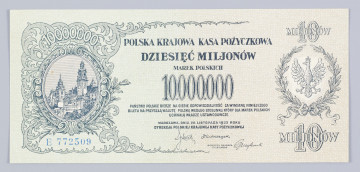
Cheque for 50,000,000 Polish marks - a template
1923
National Museum in Lublin
Part of the collection: Paper money during the Second Polish Republic
The most important challenge for the independent Polish state was to put the monetary system in order, by replacing the currencies of the partitioning states with the national currency. On 7 December 1918, it was decided that, until the establishment of the Bank of Poland, the functions of the central financial institution would be performed by the Polish National Loan Fund (PKKP), established by the Germans in 1916. The Polish marks (mkp) it issued were to become the sole means of payment in Poland. However, this required time. At the beginning of December 1919, when this banknote was introduced into circulation, the mkp was exclusive only in the Wielkopolska region. A few weeks later it gained this status in Galicia and in parts of the former Russian partition. The unification of the country's currency took place after the stabilisation of the borders in 1921 and 1922. The expansion of mkp circulation prompted not only the multiplication of issuing outlays, but also the introduction of higher denominations. The highest denomination in 1919 was the 1000 mkp banknote. The need for large denominations was related to the growing inflation, which was an effect of the emerging economic crisis related to the losses of the economies of the countries involved in the war and the need to adjust them to a peaceful mode. The decline in the purchasing power of money stemmed primarily from the war-changed nature of paper currencies, which became tokens of value - without the possibility of exchanging them for bullion coins. The mkp was also affected, and from November 1918 to the end of 1919, it lost about 13,700% against the dollar. This was particularly evident after the liquidation in November 1919 of the Exchange Head Office, which maintained its undervalued exchange rate. In the months that followed, Treasury Minister Władysław Grabski had some success in curbing inflation. However, the Polish-Bolshevik war of 1920 made it impossible to maintain budgetary discipline.
At the beginning of December 1919, an issue of "Kurier Warszawski" cost 30 pfennigs (100 pfennigs = 1 mo), and a year later it cost 5 mo.
The banknote belongs to a very popular series, designed in the Vienna State Printing House in the style of the Vienna Secession. It was printed in large numbers in the same printing house in Vienna and in Warsaw in the State Graphic Works (PWPG), the Graphic Works Bolesław Wierzbicki i S-ka and other private printing works in the capital city.
Tomasz Markiewicz
Author / creator
Dimensions
cały obiekt: height: 216 mm, width: 136 mm
Object type
paper money
Technique
Material
paper
Creation time / dating
Creation / finding place
Owner
The National Museum in Lublin
Identification number
Location / status

1923
National Museum in Lublin

1923
National Museum in Lublin

1923
National Museum in Lublin
DISCOVER this TOPIC
National Museum in Lublin
DISCOVER this PATH
Educational path